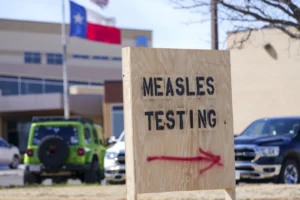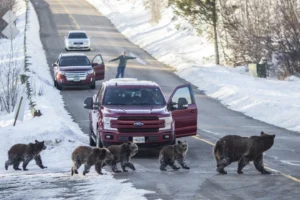Bear Activity on the Rise with the Arrival of Autumn
Changing seasons bring the increasing threat of conflicts with grizzly and black bears
- Published In: Other News & Features
- Last Updated: Sep 18, 2022
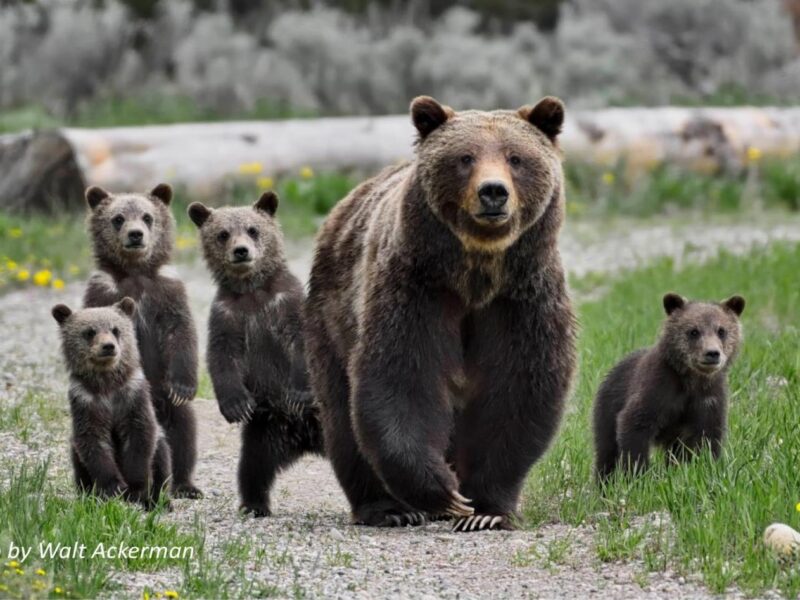
Grizzly matriarch 399 with her four cubs — born in 2021 — wandered through multiple residential neighborhoods in Jackson last fall, creating substantial concern that they would access improperly-stored attractants or damage property. (Courtesy photo from Walt Ackerman)
By Melissa Thomasma
Special to the Wyoming Truth
As fall arrives in Jackson Hole, the community is holding its breath. The season marks the peak of human/bear conflicts — and last autumn was particularly tense. The region’s most famous bear family left the safety of Grand Teton National Park and wandered into residential regions, putting their lives on the line.
One misstep and wildlife managers may have euthanized them all.
Wildlife enthusiasts around the globe paid close attention. This year, they’re hoping for the best as nonprofit organizations launch initiatives to keep “399”—the region’s most famous grizzly bear—and the area’s other bears alive.
In 2021, 399 traipsed through neighborhoods with her four cubs in tow. Her usual habitat in Grand Teton National Park was slim on food sources after a long, dry summer, and the bears sought to gobble up as many calories as possible in preparation for hibernation.
Wildlife lovers were on tenterhooks, hoping that residents would secure attractants on their properties.
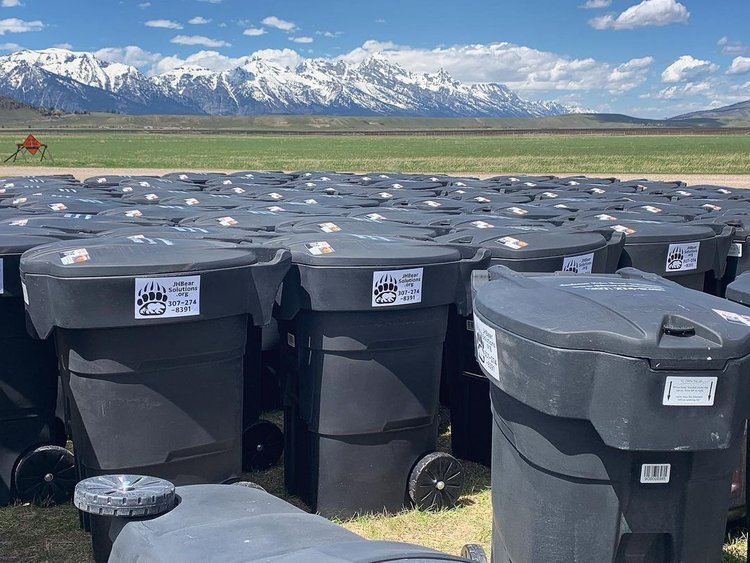
“399 and her cubs were fairly accustomed to humans to begin with since they are so popular with visitors and photographers in the national park,” said Kristin Combs, Executive Director of Wyoming Wildlife Advocates. “As they moved through residential spaces, we knew that further habituation to people or access to food rewards could be disastrous. It could have easily led to one of the world’s most famous and important grizzlies being killed by wildlife managers.”
A potentially deadly combination
Bear and human encounters rarely end well. In early September, a mountain biker on a trail near one of Jackson Hole’s most popular trailheads had a surprise encounter with an aggressive bear on a morning ride. The biker managed to escape unscathed and reported the close call to Wyoming Game & Fish Department.
In past years, people in similar situations haven’t been as lucky — nor have the bears.
Last October, elk hunter Jeremy Dickson encountered a grizzly near Wapiti. He and his hunting partner killed the bear, but not before the sow had all but torn his thumb from his hand. The final report from game and fish department summarized the incident, noting that wildlife managers tracked down and killed the grizzly’s two cubs.
In 2019, 37 year-old Jackson-based hunting guide Mark Uptain was killed by a grizzly while guiding guests on an elk hunt near Togwotee Pass, leaving behind five children. The grizzly determined to be responsible was killed, as was her cub.
“Hunters make significant efforts to be stealthy, and the gut piles left behind after successful hunts lure bears from miles away because they’re doing all they can to eat as much as possible,” Combs said.
An average grizzly consumes around 5,000 calories daily in the summer. But during hyperphagia, the period before winter hibernation, that number skyrockets to 20,000. As more people populate the areas that were once bear habitat, and as climate change diminishes traditional food sources like army cutworm moths and cutthroat trout, bears increasingly overlap with spaces that have human-created attractants, a phenomenon documented by grizzly experts, including David Mattson.
“It has been a relatively good year for natural foods,” said Mike Boyce, a Jackson large carnivore biologist. “But as berries and vegetation begin to dry up, bears commonly start showing up in developed areas this time of year. While bears may just be passing through, it’s important they do not get any food rewards, such as improperly stored garbage, that would encourage them to stay.”
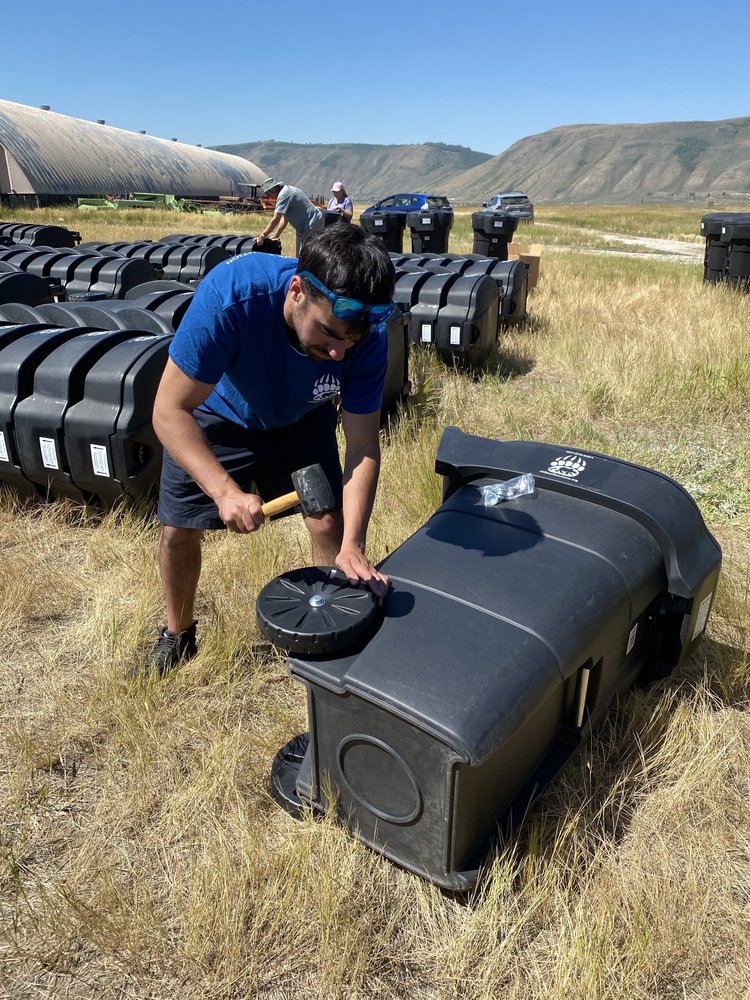
Bear Wise Wyoming Coordinator Kyle Garrett recommends bear spray to deter an aggressive bear. Bears that experience bear spray suffer no permanent harm and also receive a negative conditioning effect; they’re more likely to avoid humans in the future, according to Bear Wise.
In August, the game and fish department distributed 400 cans of bear spray to hunters at no cost.
“Bear spray is absolutely a tool that every hunter and outdoor recreationalist should carry every time they’re in the field — especially this time of year,” said Combs, pointing to studies in 2010 and 2012 from Brigham Young University that found it to be 93% effective in stopping a bear.
Defending the home front
Bears are increasingly likely to encounter problematic sources of food as they traverse the mountains and valleys of Wyoming, driven by their peaking caloric demand. They find fruit trees, gardens, pet or livestock food, grills, chicken coops, bee hives and garbage irresistible, according to Bear Wise.
In August, the Town of Jackson joined Teton County in establishing regulations that require residents to use bear-resistant trash cans and to ensure that other attractants are secured from ursine access. These regulations will take full effect in April of 2023.
Recognizing the cost associated with compliance, Wyoming Wildlife Advocates launched a new program to remove that barrier: JH Bear Solutions. As an arm of the nonprofit, it offers reduced and zero-cost resources to community members.
So far, the organization has distributed over 300 bear-resistant cans and is working with local residents to add electric fencing to gardens, chicken coops and beehives, Combs said. The group also enlists volunteers to help remove attractants or clean up fallen fruit.
Brian Hagar, a high school teacher, runs a small family farm with his wife. They sought assistance from JH Bear Solutions to secure their duck and chicken enclosures.
“Jackson Hole Bear Solutions was very responsive and receptive to our unique need for moveable electric fencing systems in order to protect our farmstead operation, as well as the bears with whom we share this amazing space,” Hagar said. “It would have been a struggle to be in compliance with the county regulations without their help.”
Additionally, the program is partnering with Farmstead Cider, an artisanal cider brewery in Jackson Hole that crafts products utilizing locally harvested fruit. Through its “Harvest Helper” outreach, the group supports private landowners by volunteering to pick their apples, crabapples, chokecherries, tart cherries and more.
“Bears are an essential part of our Wyoming heritage because the wild landscape around us is at the core of our character,” said Combs. “Nobody wants to imagine a Wyoming without bears, and everyone can easily do their part to keep themselves and our bears safe throughout the fall and beyond.”
And what of 399? As of mid-September, she hasn’t been spotted beyond the borders of Grand Teton National Park, though that could change any day. Her cubs, now over a year old, are on their own. Wildlife managers killed one of the four earlier in 2022 for habituation and conflict with humans.
People who treasure 399—and other bears like her—are hoping she doesn’t meet the same fate.

